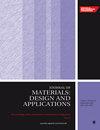Compression properties of cellular iron lattice structures used to mimic bone characteristics
IF 2.2
4区 材料科学
Q3 MATERIALS SCIENCE, MULTIDISCIPLINARY
Proceedings of the Institution of Mechanical Engineers, Part L: Journal of Materials: Design and Applications
Pub Date : 2024-03-26
DOI:10.1177/14644207241241799
引用次数: 0
Abstract
Recently, cellular materials made by the repetition of unit cells, that is, iron lattices have become appealing to mimic the structure of bone. The aim of the study is to choose the most adequate lattice structures, which have the compressive mechanical properties closer to the ones of bone, in the perspective of their use as temporary implants. Five types of unit cells were selected, such as, cubic (C), truncated octahedron (TO), truncated cubic (TC), rhombicuboctahedron (RCO), and rhombitrucated cuboctahedron (RTCO). The mechanical properties were assessed by numerical simulations with a finite-element analysis. The size effect was studied with the comparison of results among samples with different numbers of unit cells. Simulations covered a wide range of relative densities. Graded dense-in and dense-out configurations were constructed with lattices of types RTCO and TO, being the unit cells, themselves graded. Lattice structures RTCO and TO were found to be stable at every relative density studied, while C, TC and RCO lattices are unstable at low densities. The evaluation of size effects was not conclusive, which could be biased by other factors. The Young's modulus of RTCO and TO lattices enable to reproduce the properties of both trabecular and cortical bone, with an appropriate choice of the relative density. To mimic trabecular bone, only RTCO and TO structures with low relative densities, can be used, while arrangements of C, TC and RCO cells can only replicate the properties of cortical bone. Graded cells may have the same properties as non-graded with lower density.用于模拟骨骼特征的细胞铁晶格结构的压缩特性
最近,通过重复单元格(即铁晶格)制成的细胞材料在模仿骨骼结构方面颇具吸引力。这项研究的目的是选择最合适的晶格结构,使其具有更接近骨骼的压缩机械性能,以用作临时植入物。我们选择了五种单元格,如立方体(C)、截断八面体(TO)、截断立方体(TC)、菱形立方体(RCO)和菱形截断立方体(RTCO)。通过有限元分析的数值模拟对其机械性能进行了评估。通过比较具有不同单元格数的样品的结果,研究了尺寸效应。模拟涵盖了广泛的相对密度范围。利用 RTCO 和 TO 类型的晶格构建了分级密入和密出配置,这些晶格是本身分级的单元格。研究发现,RTCO 和 TO 晶格结构在每个相对密度下都是稳定的,而 C、TC 和 RCO 晶格在低密度下则不稳定。对尺寸效应的评估没有得出结论,这可能受到其他因素的影响。只要适当选择相对密度,RTCO 和 TO 晶格的杨氏模量就能再现骨小梁和皮质骨的特性。要模拟骨小梁,只能使用相对密度较低的 RTCO 和 TO 结构,而 C、TC 和 RCO 细胞的排列只能复制皮质骨的特性。分级细胞的特性可能与密度较低的非分级细胞相同。
本文章由计算机程序翻译,如有差异,请以英文原文为准。
求助全文
约1分钟内获得全文
求助全文
来源期刊

CiteScore
4.70
自引率
8.30%
发文量
166
审稿时长
3 months
期刊介绍:
The Journal of Materials: Design and Applications covers the usage and design of materials for application in an engineering context. The materials covered include metals, ceramics, and composites, as well as engineering polymers.
"The Journal of Materials Design and Applications is dedicated to publishing papers of the highest quality, in a timely fashion, covering a variety of important areas in materials technology. The Journal''s publishers have a wealth of publishing expertise and ensure that authors are given exemplary service. Every attention is given to publishing the papers as quickly as possible. The Journal has an excellent international reputation, with a corresponding international Editorial Board from a large number of different materials areas and disciplines advising the Editor." Professor Bill Banks - University of Strathclyde, UK
This journal is a member of the Committee on Publication Ethics (COPE).
 求助内容:
求助内容: 应助结果提醒方式:
应助结果提醒方式:


